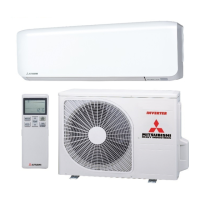
Do you have a question about the Mitsubishi Heavy Industries SRK15ZS-WF and is the answer not in the manual?
| Type | Split System |
|---|---|
| Cooling Capacity | 1.5 kW |
| Power Supply | 220-240V, 50Hz |
| Refrigerant | R32 |
| Indoor Unit Dimensions (W x H x D) | 870 x 290 x 230 mm |
| Weight (Outdoor Unit) | 30 kg |
| Energy Efficiency Class Cooling | A++ |
| Energy Efficiency Class Heating | A+ |
| Noise Level (Indoor) | 19 dB(A) |
| Features | Wi-Fi Control, Self-Cleaning |
| Noise Level (Outdoor) | 50 dB(A) |
Specific safety rules to follow during the air conditioner's installation process.
Critical safety measures to adhere to during the daily use of the air conditioner.
Safety warnings related to the use of the air conditioner's wireless LAN connectivity.
Safety advice for moving the unit or performing any repair work.
Detailed description of parts found within the indoor air conditioning unit.
Detailed description of parts found within the outdoor air conditioning unit.
Explanation of the indicators and lights on the air conditioner's main unit display.
List and description of items included with the air conditioner for its operation.
Instructions on how to properly install batteries in the remote control.
Guidance on mounting and using the provided remote control holder.
Troubleshooting steps for when the remote control is not functioning correctly.
How to operate the unit using the manual ON/OFF button on the unit itself.
Procedure for configuring the remote control to manage multiple indoor units.
How room layout affects the optimal airflow range setting.
Explains the purpose and operation of each button on the remote control.
Specifies the optimal operating temperature and humidity ranges for the unit.
Details on how the heating mode functions and its capacity reduction in cold weather.
How to enable or disable the weekly timer scheduling.
Steps to remove individual timer settings.
How to change the brightness level of the unit's display.
Setting up the air conditioner's connection to a wireless network.
Actions to take before performing any maintenance tasks.
Regular maintenance tasks to perform during the period of use.
Recommendations for the best location to install the unit.
Advice on minimizing noise and vibration during operation.
Recommended periodic checks and professional maintenance services.
Explains various sounds the unit might make and their potential causes.
Describes common operational problems like timer cancellation or display mismatches.
Details on other non-standard behaviors such as restart delays or smell.
How the unit resumes operation after a power interruption.
Considerations for operating multiple indoor units simultaneously.
